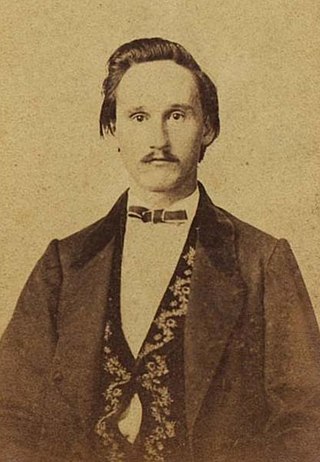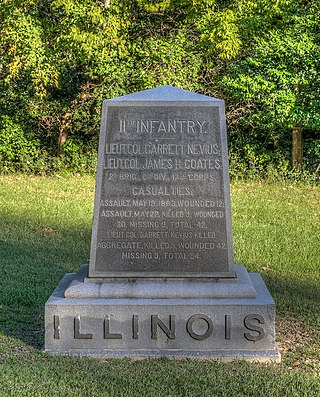
The siege of Port Hudson, Louisiana, was the final engagement in the Union campaign to recapture the Mississippi River in the American Civil War.

John Clifford Pemberton was a career United States Army officer who fought in the Seminole Wars and with distinction during the Mexican–American War. He resigned his commission to serve as a Confederate lieutenant-general during the American Civil War. He led the Army of Mississippi from December 1862 to July 1863 and was the commanding officer during the Confederate surrender at the Siege of Vicksburg.

Laurent Millaudon was a wooden side-wheel river steamboat launched at Cincinnati, Ohio, in 1856 operating in the New Orleans, Louisiana, area, and captained by W. S. Whann. At the beginning of the American Civil War she was taken into service by the Confederate Navy as CSS General Sterling Price. On 6 June 1862, she was sunk at the Battle of Memphis. She was raised and repaired by the Union army, and on 16 June 1862 was moved into Union service as USS General Price and served until the end of the war.

New Orleans, Louisiana, was the largest city in the South, providing military supplies and thousands of troops for the Confederate States Army. Its location near the mouth of the Mississippi made it a prime target for the Union, both for controlling the huge waterway and crippling the Confederacy’s vital cotton exports.

Franklin Kitchell Gardner was a Confederate major general in the American Civil War, noted for his service at the Siege of Port Hudson on the Mississippi River. Gardner built extensive fortifications at this important garrison, 16,000 strong at its peak. At the mercy of conflicting orders, he found himself besieged and greatly outnumbered. His achievement at holding out for 47 days and inflicting severe losses on the enemy before surrendering has been praised by military historians.
The Pointe Coupee Artillery was a Confederate Louisiana artillery unit in the American Civil War made up primarily of men from the parishes of Pointe Coupee, East Baton Rouge, Livingston and other surrounding parishes as well as a large number of men from New Orleans.

The 10th Arkansas Infantry (1861–1865) was a Confederate Army infantry regiment during the American Civil War from the state of Arkansas. The unit is also known as A. R. Witt's Infantry, C. M. Cargile's Infantry, E. L. Vaughan's Infantry, Thomas D. Merrick's Infantry, S. S. Ford's Infantry, Obed Patty's Infantry, George A. Merrick's Infantry, Zebulon Venable's Infantry and Robert C. Bertrand's Infantry in contemporary accounts. After being captured at the Siege of Port Hudson, the unit reorganized as a mounted infantry unit, and was known as the 10th Arkansas Cavalry Regiment or Witt's Arkansas Cavalry.
The 12th Arkansas Infantry (1861–1865) was a Confederate Army infantry regiment during the American Civil War. The regiment spent much of its service defending Confederate strong points along the Mississippi River. The unit participated in the defense of Island No. 10 in early 1862 and later became part of the garrison of Port Hudson in 1863. Following the capitulation of the garrison of Port Hudson, the survivors of the 12th were eventually paroled and exchanged back to Arkansas where the regiment was consolidated with the remnants of several other Arkansas regiments to become the 2nd Arkansas Consolidated Infantry Regiment.
The 19th Arkansas Infantry Regiment or Dockery's Arkansas Infantry Regiment was an infantry formation of the Confederate States Army during the American Civil War. There were two other regiments which were designated as the 19th Arkansas. Dawson's 19th Arkansas Infantry was organized at Nashville, Arkansas, on November 21, 1861. Hardy's Arkansas Infantry, which is also occasionally referred to as the 19th Arkansas was organized in 1863 from those parts of Dawson's 19th Infantry Regiment, the 24th Arkansas Infantry Regiment and Crawford's Arkansas Infantry Battalion, which escaped capture at the Battle of Arkansas Post.
The 20th Arkansas Infantry (1861–1865) was a Confederate Army infantry regiment during the American Civil War. The unit was also known as the 22nd Arkansas Infantry. When the unit was reorganized following its capture at the Siege of Vicksburg, it was officially redesignated as the 41st Arkansas Infantry (Mounted), by the Arkansas State Military Board, but this redesignation was completely ignored by the unit and Confederate authorities. The unit participated in the Camden Expedition and Price's Missouri Expedition as a mounted infantry unit.

Edward Higgins was a Confederate States Army brigadier general during the American Civil War. Before the war, he spent almost 20 years in the United States Navy and 7 years as a merchant steamship agent. After the war, he was an insurance and import sales agent at Norfolk, Virginia and from 1872 to 1875 was an agent for the Pacific Mail Steamship Company.

The 11th Regiment Illinois Volunteer Infantry was an infantry regiment from Illinois that served in the Union Army during the American Civil War. In April 1861, it was formed as a three-month volunteer unit, and in July 1861 it was reorganized as a three-year unit, in which role it served until the end of the war. Two of its commanding officers were promoted to brigadier general and led major units during the war. In its first major action at Fort Donelson the regiment suffered terrible losses. The 11th Illinois also fought at Shiloh, Riggins Hill, Vicksburg, First Yazoo City, Second Yazoo City, and Fort Blakely. In April 1863, the 109th Illinois Infantry Regiment was disbanded and its enlisted men transferred into the 11th Illinois. The regiment was mustered out of service in July 1865.

Thomas E. Atkinson was a Union Navy sailor in the American Civil War and a recipient of the U.S. military's highest decoration, the Medal of Honor, for his actions at the Battle of Mobile Bay.
The 1st Arkansas Field Battery (1861–1865) was a Confederate Army artillery battery during the American Civil War. Also known as: the "John D. Adams Artillery," or usually just "Adams Artillery"; Gaines' Battery; McNally's Battery. The battery made the crossing of the Mississippi River in April 1862 with Major General Earl Van Dorn's Army of the West. After being surrendered at the conclusion of the Vicksburg Campaign, the battery was reorganized in the Department of the Trans-Mississippi and served there for the remainder of the war.
Company B, 1st Tennessee Heavy Artillery (1861-1864) was a Confederate Army artillery battery during the American Civil War. While the unit was assigned to a Tennessee Artillery Regiment, it was originally organized as the McCown Guards or the McCown Guards Artillery, a volunteer company organized in Lafayette County, Arkansas. Also known as: Company A, 1st Tennessee Heavy Artillery and/or Dismukes' Battery.
Preston Pond Jr. was a lawyer and politician from Louisiana, who served as a colonel in the Confederate States Army during the American Civil War.

The 17th Louisiana Infantry Regiment was a unit of volunteers recruited in Louisiana that fought in the Confederate States Army during the American Civil War. The regiment formed at Camp Moore in September 1861 and served during the war in the Western Theater of the American Civil War. The unit stayed in New Orleans until February 1862 and then moved north to Corinth, Mississippi. The regiment first saw action at Shiloh in April 1862 while serving in Patton Anderson's brigade. Afterwards, the regiment redeployed to the Vicksburg area and repelled Sherman's attack at Chickasaw Bayou that December. In 1863 the regiment took part in the Vicksburg campaign, first fighting at Port Gibson and then at the Siege of Vicksburg in William Baldwin's brigade. On July 4th, 1863 the regiment was surrendered along with all other Confederate soldiers at Vicksburg. The soldiers were paroled and went home. The regiment reported to a parole camp at Shreveport, Louisiana, in January 1864. The regiment was on garrison duty in western Louisiana for the remainder of the war, before disbanding in May 1865.

The 22nd Louisiana Infantry Regiment was a unit of volunteers recruited in Louisiana that fought in the Confederate States Army during the American Civil War. The regiment formed in April 1862 at New Orleans and served during the war in the Western Theater of the American Civil War. The men trained as gunners for heavy artillery and the regiment was split up to garrison various forts. Two companies were assigned to hold Fort Jackson, fought in the Defense of Fort Jackson, and surrendered afterward. One company made a futile defense during the Capture of New Orleans. The regiment reorganized at Camp Moore and traveled to Vicksburg, Mississippi, to participate in its defense. The unit was renamed the 21st Louisiana Infantry Regiment in January 1863. Elements of the regiment assisted in the repulse of the Yazoo Pass expedition. The soldiers served at the Siege of Vicksburg, surrendered when the city fell, and afterward reported to a parole camp. In January 1864, the 22nd Consolidated Louisiana Infantry Regiment was reconstituted with 780 men from seven different Louisiana units that had surrendered at Vicksburg. The unit was ordered to Mobile, Alabama, where four companies fought at Spanish Fort in March and April 1865. The regiment surrendered in May 1865.

The 23rd Louisiana Infantry Regiment was a unit of volunteers recruited in Louisiana that fought in the Confederate States Army during the American Civil War. The regiment organized in January 1862 at New Orleans by merging the Orleans Artillery Battalion, a state militia unit, with six independent companies. In March 1862, the unit mustered into Confederate service with 841 men and served during the war in the Western Theater of the American Civil War. The various companies were allocated to defend various forts. One company was assigned to hold Fort Jackson, fought in the Battle of Forts Jackson and St. Philip, and surrendered when the fort fell. After the Capture of New Orleans most of the companies disbanded. However, four companies reorganized at Camp Moore in May 1862 and traveled to Vicksburg, Mississippi where they manned the river batteries. In early 1863, the regiment was renamed the 22nd Louisiana Infantry Regiment. The soldiers went to Fort Pemberton where they helped drive off the Yazoo Pass expedition. The regiment was part of the garrison during the Siege of Vicksburg and was captured and paroled when the city fell in July 1863. The men reported to a parole camp. In January 1864, it and the remnants of six other Louisiana regiments were absorbed into the 22nd Consolidated Louisiana Infantry Regiment. This unit fought at Spanish Fort in March and April 1865 and surrendered at Meridian, Mississippi in May 1865.

The 1st Louisiana Field Battery was an artillery unit recruited from volunteers in Louisiana that fought in the Confederate States Army during the American Civil War. The battery mustered into Confederate service in October 1861. The unit traveled to Fort Jackson in early 1862 and took part in the defense of Forts Jackson and St. Philip. The soldiers became prisoners when the forts surrendered and the battery reformed at Franklin after their prisoner exchange. The battery fought at Fort Bisland and Irish Bend in 1863. Later in the year the battery engaged Union shipping on the rivers in several actions. In 1864 the battery briefly fought at Mansfield before its commander was killed while engaging Union gunboats on the Red River. The unit also fought at Mansura and Yellow Bayou. The battery was in Texas when the Trans-Mississippi Department surrendered in May 1865.













